
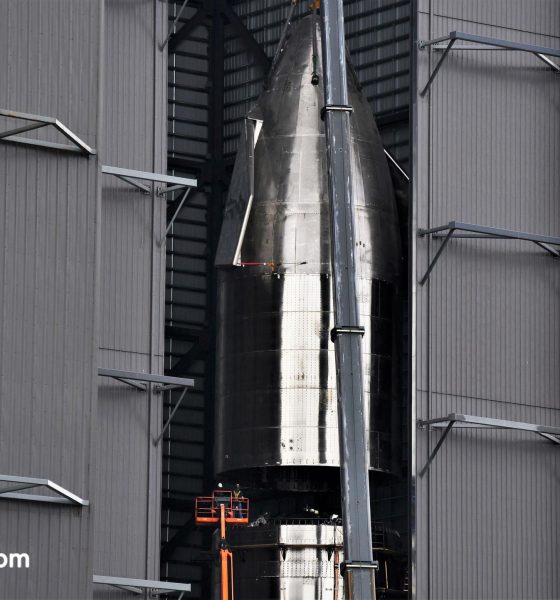
News
SpaceX backup Starship reaches full height after nosecone installation
SpaceX has installed another Starship’s nosecone, all but completing the second full-size prototype a matter of days before the first fully-assembled Starship’s risky launch debut.
Over the last two months, SpaceX has effectively put Starship number 8 (SN8) through an almost nonstop series of tests, completing at least four separate cryogenic proof tests, four Raptor engine static fires, and much more. The company’s South Texas team have also dodged an array of technical bugs; installed, plumbed, and wired what amounts to ~40% of Starship (the nose section) while fully exposed to the coastal elements; and even narrowly avoided a potentially catastrophic failure.
In spite of the many hurdles thrown up and delays resultant, CEO Elon Musk announced earlier this week that Starship SN8 is scheduled to attempt its 15-kilometer (~50,000 ft) launch debut as early as Monday, November 30th. Musk, however, does not see success as the most probable outcome.
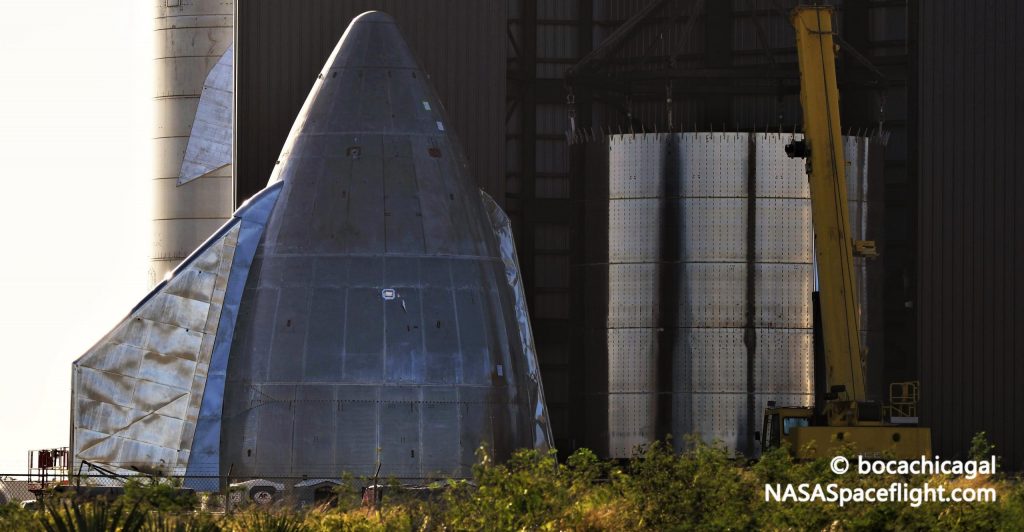
Why, then, push to launch Starship SN8 when, in Musk’s own words, the probability of success is as low as “33%”? As previously discussed many times in the history of Teslarati’s BFR and Starship coverage, SpaceX’s attitude towards technology development is (unfortunately) relatively unique in the aerospace industry. While once a backbone of major parts of NASA’s Apollo Program moonshot, modern aerospace companies simply do not take risks, instead choosing a systems engineering methodology and waterfall-style development approach, attempting to understand and design out every single problem to ensure success on the first try.
The result: extremely predictable, conservative solutions that take huge sums of money and time to field but yield excellent reliability and all but guarantee moderate success. SpaceX, on the other hand, borrows from early US and German rocket groups and, more recently, software companies to end up with a development approach that prioritizes efficiency, speed, and extensive testing, forever pushing the envelope and thus continually improving whatever is built.
In the early stages of any program, the results of that approach can look extremely unusual and rudimentary without context (i.e. Starhopper, above), but building and testing a minimum viable product or prototype is a very intentional foundation. Particularly at the start, those minimal prototypes are extremely cheap and almost singularly focused on narrowing a vast range of design options to something more palatable. As those prototypes rapidly teach their builders what the right and wrong questions and design decisions are, more focused and refined prototypes are simultaneously built and tested.
Done well, the agile approach is often quite similar to evolution, where prototype failures inform necessary design changes and killing off dead-end strategies, designs, and assumptions before they can be built upon. In many cases, compared to cautious waterfall-style development, it will even produce results that are both better, cheaper, and faster to realize. SpaceX’s Starship program is perhaps the most visible example in history, made all the more interesting and controversial by the fact that it’s still somewhere in between its early, chaotic development phase and a clear path to a viable product.
On the build side of things, SpaceX has created a truly incredible ad hoc factory from next to nothing, succeeding to the point that the company is now arguably testing and pushing the envelope too slowly. As of November 2020, no fewer than eight full-size Starships and the first Super Heavy booster prototype are visibly under construction. Most recently, Starship SN9 was stacked to its full height, kicking off nosecone installation while still at the build site (unlike SN8). SN10’s completed tank section is likely ready to begin flap installation within the next few days, while Starship SN11 is perhaps a week or two behind that. Additionally, large tank sections of Starships SN12, SN13, SN14, SN15, and (most likely) SN16 are already completed and have all been spotted in the last few weeks.
Some ~90% of the above work was likely started after Starship SN8 first left the factory and rolled to the launch pad on September 26th. In many regards, SN8 has been the first to reach multiple major milestones, largely explaining the relatively plodding pace of its test program compared to SN4, SN5, and SN6.

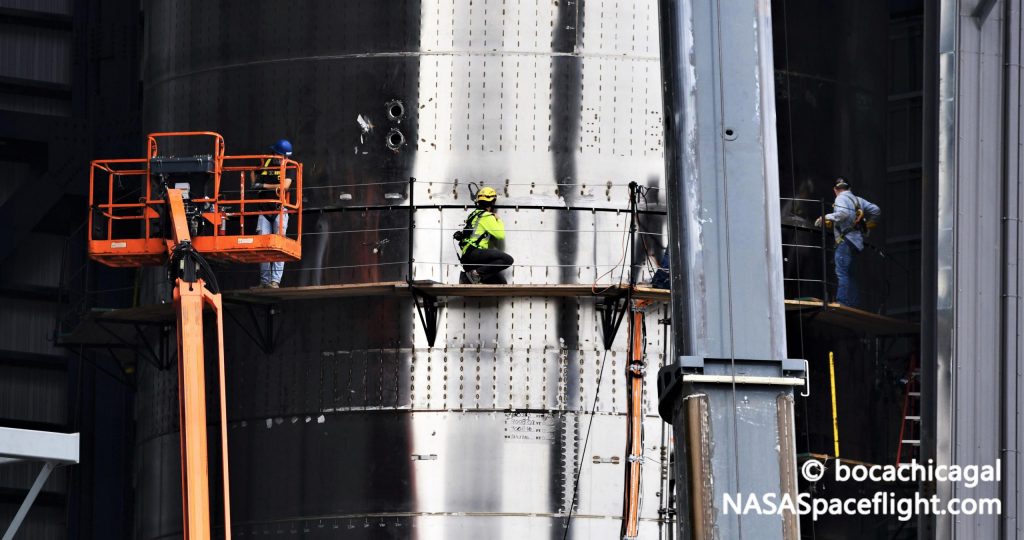
Ultimately, SN9’s imminent completion – effectively a superior, more refined copy of SN8 – means that Starship SN8’s utility to SpaceX is rapidly deteriorating. The company would almost assuredly never skip an opportunity to learn, meaning that there’s no plausible future in which SN8 testing doesn’t continue, but that doesn’t mean that SpaceX can’t turn its risk tolerance to 11. In essence, accept a 67% (or higher) chance of Starship SN8’s violent destruction but learn as much as possible in the process. As long as good data is gathered, SN8’s launch debut will be a success for Starship whether the rocket lands in one or several pieces.

Elon Musk
SpaceX Starship Version 3 booster crumples in early testing
Photos of the incident’s aftermath suggest that Booster 18 will likely be retired.
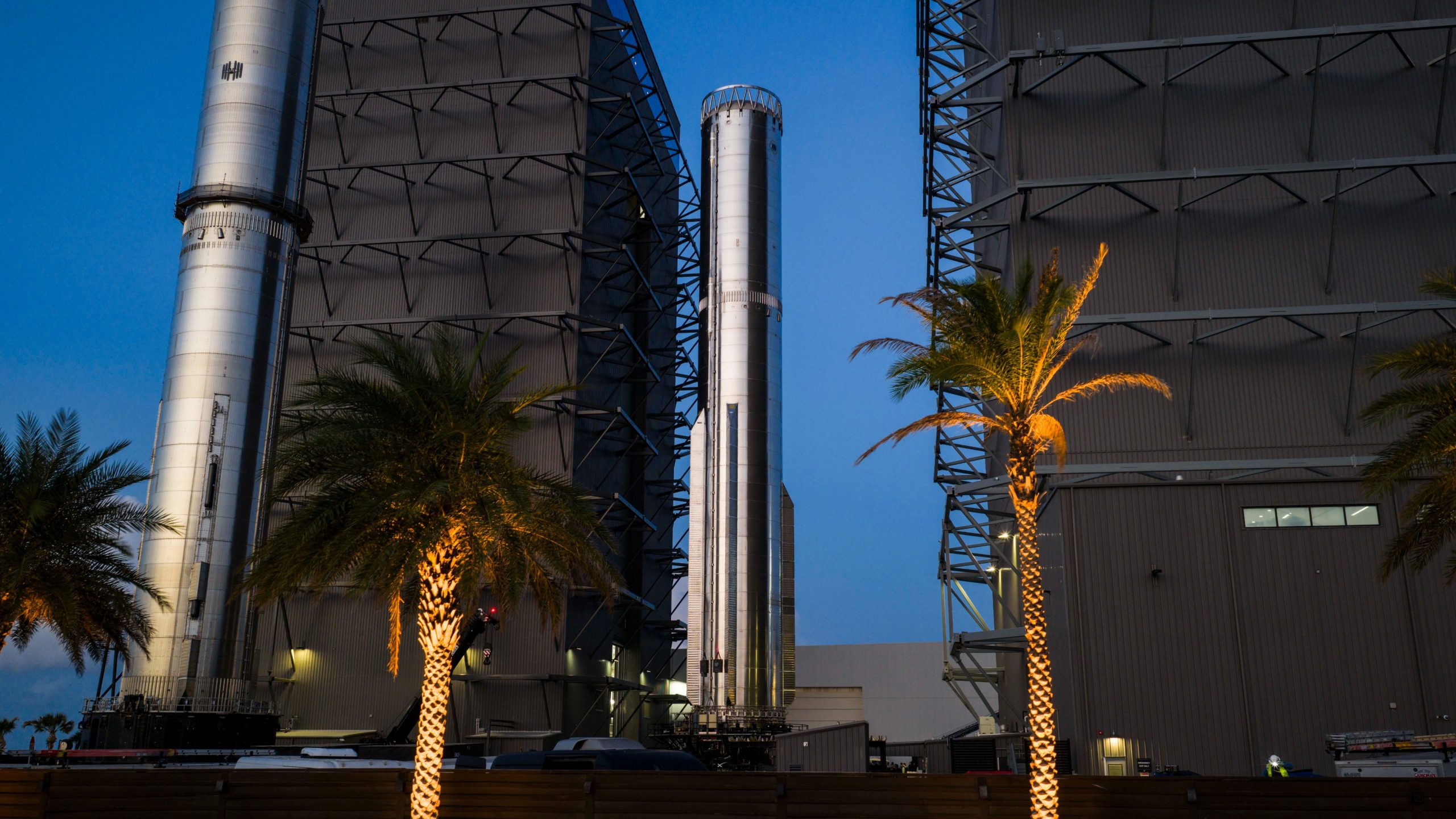
SpaceX’s new Starship first-stage booster, Booster 18, suffered major damage early Friday during its first round of testing in Starbase, Texas, just one day after rolling out of the factory.
Based on videos of the incident, the lower section of the rocket booster appeared to crumple during a pressurization test. Photos of the incident’s aftermath suggest that Booster 18 will likely be retired.
Booster test failure
SpaceX began structural and propellant-system verification tests on Booster 18 Thursday night at the Massey’s Test Site, only a few miles from Starbase’s production facilities, as noted in an Ars Technica report. At 4:04 a.m. CT on Friday, a livestream from LabPadre Space captured the booster’s lower half experiencing a sudden destructive event around its liquid oxygen tank section. Post-incident images, shared on X by @StarshipGazer, showed notable deformation in the booster’s lower structure.
Neither SpaceX nor Elon Musk had commented as of Friday morning, but the vehicle’s condition suggests it is likely a complete loss. This is quite unfortunate, as Booster 18 is already part of the Starship V3 program, which includes design fixes and upgrades intended to improve reliability. While SpaceX maintains a rather rapid Starship production line in Starbase, Booster 18 was generally expected to validate the improvements implemented in the V3 program.
Tight deadlines
SpaceX needs Starship boosters and upper stages to begin demonstrating rapid reuse, tower catches, and early operational Starlink missions over the next two years. More critically, NASA’s Artemis program depends on an on-orbit refueling test in the second half of 2026, a requirement for the vehicle’s expected crewed lunar landing around 2028.
While SpaceX is known for diagnosing failures quickly and returning to testing at unmatched speed, losing the newest-generation booster at the very start of its campaign highlights the immense challenge involved in scaling Starship into a reliable, high-cadence launch system. SpaceX, however, is known for getting things done quickly, so it would not be a surprise if the company manages to figure out what happened to Booster 18 in the near future.
News
Tesla FSD (Supervised) is about to go on “widespread” release
In a comment last October, Elon Musk stated that FSD V14.2 is “for widespread use.”
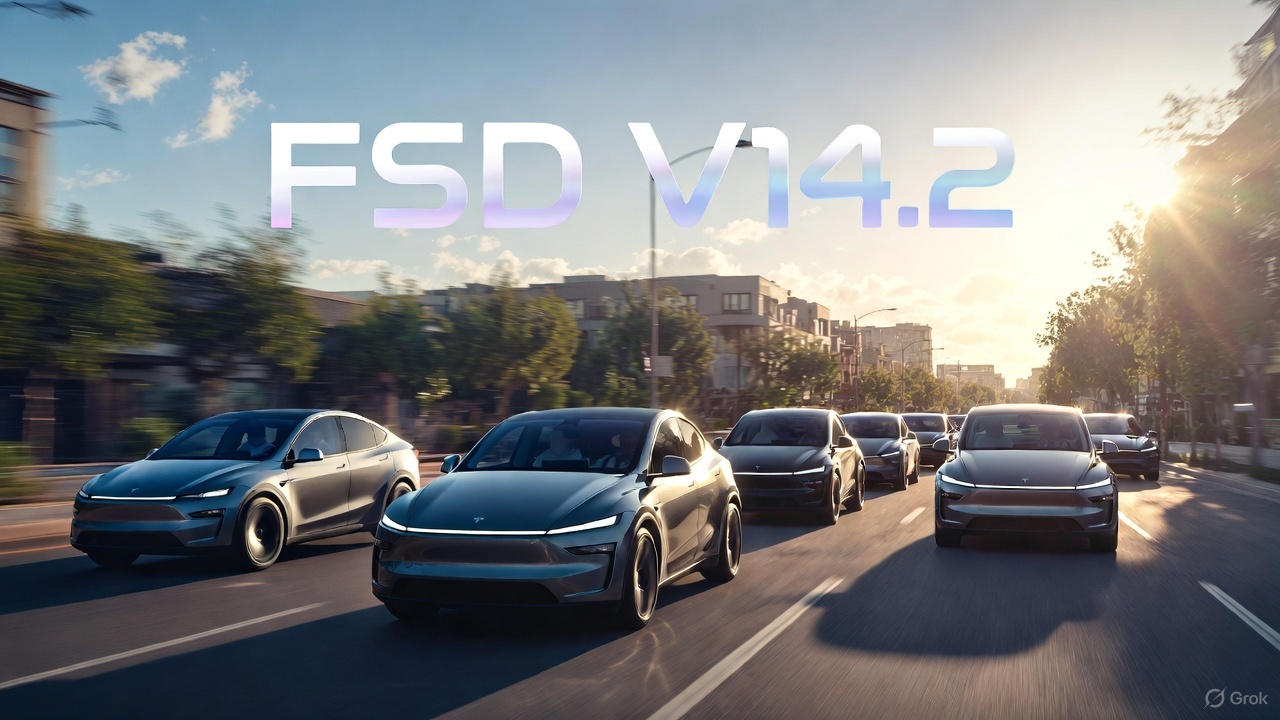
Tesla has begun rolling out Full Self-Driving (Supervised) V14.2, and with this, the wide release of the system could very well begin.
The update introduces a new high-resolution vision encoder, expanded emergency-vehicle handling, smarter routing, new parking options, and more refined driving behavior, among other improvements.
FSD V14.2 improvements
FSD (Supervised) V14.2’s release notes highlight a fully upgraded neural-network vision encoder capable of reading higher-resolution features, giving the system improved awareness of emergency vehicles, road obstacles, and even human gestures. Tesla also expanded its emergency-vehicle protocols, adding controlled pull-overs and yielding behavior for police cars, fire trucks, and ambulances, among others.
A deeper integration of navigation and routing into the vision network now allows the system to respond to blocked roads or detours in real time. The update also enhances decision-making in several complex scenarios, including unprotected turns, lane changes, vehicle cut-ins, and interactions with school buses. All in all, these improvements should help FSD (Supervised) V14.2 perform in a very smooth and comfortable manner.
Elon Musk’s predicted wide release
The significance of V14.2 grows when paired with Elon Musk’s comments from October. While responding to FSD tester AI DRIVR, who praised V14.1.2 for fixing “95% of indecisive lane changes and braking” and who noted that it was time for FSD to go on wide release, Musk stated that “14.2 for widespread use.”
FSD V14 has so far received a substantial amount of positive reviews from Tesla owners, many of whom have stated that the system now drives better than some human drivers as it is confident, cautious, and considerate at the same time. With V14.2 now rolling out, it remains to be seen if the update also makes it to the company’s wide FSD fleet, which is still populated by a large number of HW3 vehicles.
News
Tesla FSD V14.2 starts rolling out to initial batch of vehicles
It would likely only be a matter of time before FSD V14.2 videos are posted and shared on social media.
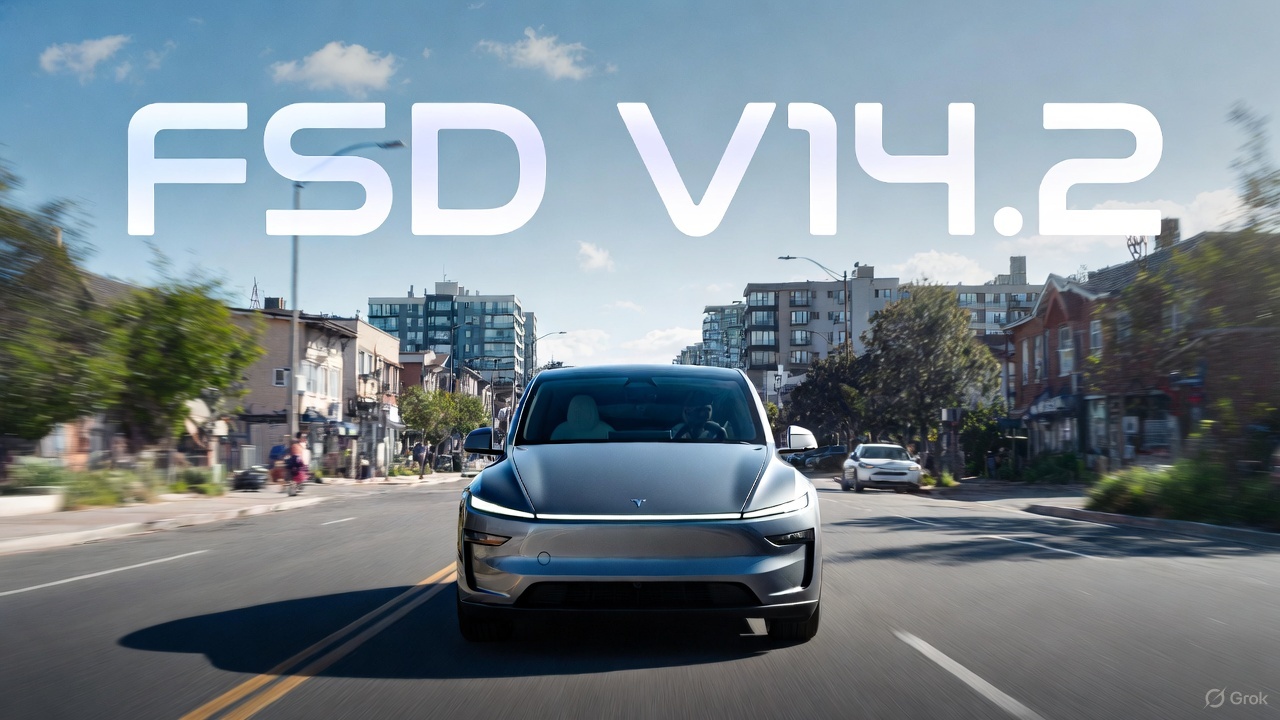
Tesla has begun pushing Full Self-Driving (Supervised) v14.2 to its initial batch of vehicles. The update was initially observed by Tesla owners and veteran FSD users on social media platform X on Friday.
So far, reports of the update have been shared by Model Y owners in California whose vehicles are equipped with the company’s AI4 hardware, though it would not be surprising if more Tesla owners across the country receive the update as well.
Based on the release notes of the update, key improvements in FSD V14.2 include a revamped neural network for better detection of emergency vehicles, obstacles, and human gestures, as well as options to select arrival spots.
It would likely only be a matter of time before FSD V14.2 videos are posted and shared on social media.
Following are the release notes of FSD (Supervised) V14.2, as shared on X by longtime FSD tester Whole Mars Catalog.
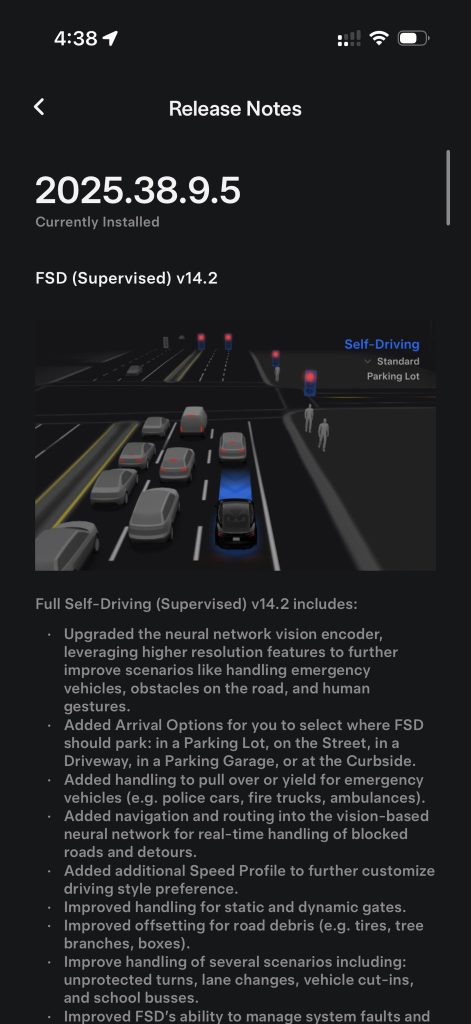
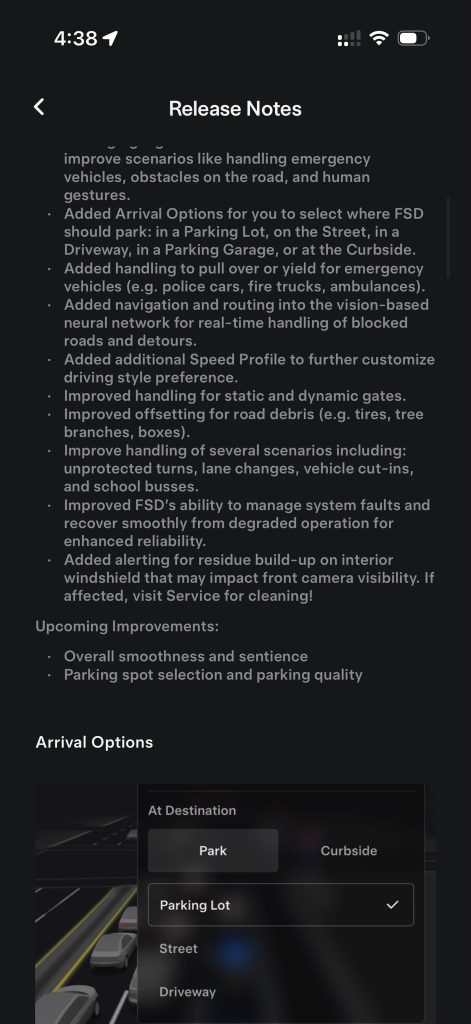
Release Notes
2025.38.9.5
Currently Installed
FSD (Supervised) v14.2
Full Self-Driving (Supervised) v14.2 includes:
- Upgraded the neural network vision encoder, leveraging higher resolution features to further improve scenarios like handling emergency vehicles, obstacles on the road, and human gestures.
- Added Arrival Options for you to select where FSD should park: in a Parking Lot, on the Street, in a Driveway, in a Parking Garage, or at the Curbside.
- Added handling to pull over or yield for emergency vehicles (e.g. police cars, fire trucks, ambulances.
- Added navigation and routing into the vision-based neural network for real-time handling of blocked roads and detours.
- Added additional Speed Profile to further customize driving style preference.
- Improved handling for static and dynamic gates.
- Improved offsetting for road debris (e.g. tires, tree branches, boxes).
- Improve handling of several scenarios including: unprotected turns, lane changes, vehicle cut-ins, and school busses.
- Improved FSD’s ability to manage system faults and improve scenarios like handling emergency vehicles, obstacles on the road, and human gestures.
- Added Arrival Options for you to select where FSD should park: in a Parking Lot, on the Street, in a Driveway, in a Parking Garage, or at the Curbside.
- Added handling to pull over or yield for emergency vehicles (e.g. police cars, fire trucks, ambulances).
- Added navigation and routing into the vision-based neural network for real-time handling of blocked roads and detours.
- Added additional Speed Profile to further customize driving style preference.
- Improved handling for static and dynamic gates.
- Improved offsetting for road debris (e.g. tires, tree branches, boxes).
- Improve handling of several scenarios, including unprotected turns, lane changes, vehicle cut-ins, and school buses.
- Improved FSD’s ability to manage system faults and recover smoothly from degraded operation for enhanced reliability.
- Added alerting for residue build-up on interior windshield that may impact front camera visibility. If affected, visit Service for cleaning!
Upcoming Improvements:
- Overall smoothness and sentience
- Parking spot selection and parking quality








